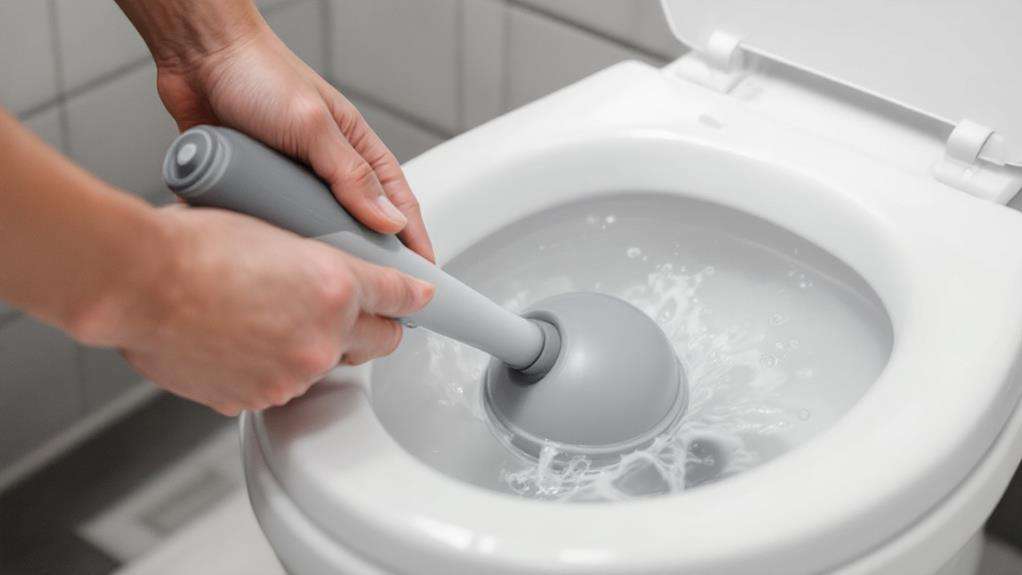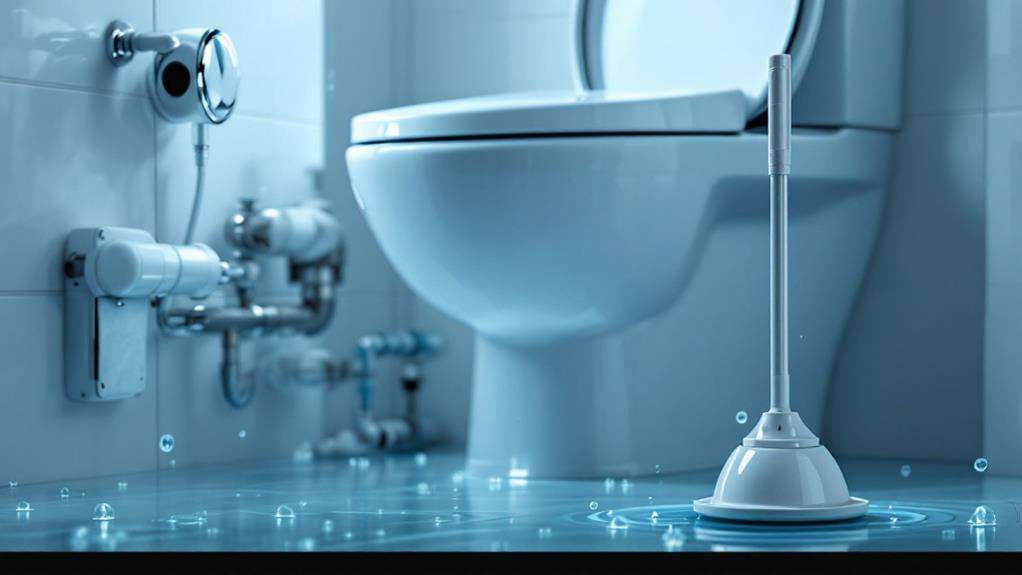Why a Good Plunger Is Essential for Every Bathroom
A good plunger is essential for every bathroom because it's your first line of defense against clogs. You'll save time, money, and frustration by quickly addressing minor blockages before they become major problems. The right plunger, whether it's a cup, flange, or accordion type, can effectively clear most clogs in toilets, sinks, and tubs. Proper plunging technique and regular maintenance guarantee your plunger remains effective and hygienic. By keeping a quality plunger on hand and using it promptly, you'll prevent costly repairs and potential water damage. Understanding the different types and their uses can help you tackle any clog with confidence.
Types of Toilet Plungers
Several types of toilet plungers are available, each designed for specific purposes. When choosing a plunger for your bathroom, you'll want to examine the specific needs of your drains and the types of clogs you're likely to encounter.
Cup plungers are the most common and recognizable type. They feature a straight handle with a rubber cup, making them ideal for flat surfaces like sink and tub drains. While they're not the best choice for toilets, they're versatile enough to handle many household clogs.
Flange plungers are the most versatile option for your bathroom. They have a cup with a soft rubber flap that creates a better seal on toilet drains, making them effective for unclogging toilets. You can also use them on sinks and tubs, making them a great all-in-one solution.
For tough toilet clogs, you might want to scrutinize an accordion plunger. These have a smaller cup and a hard plastic accordion design that creates strong suction. They're specifically designed for toilets and can tackle even the most stubborn clogs.
Choosing the Right Plunger
When it comes to choosing the right plunger, you'll need to contemplate the specific needs of your household. The flange plunger stands out as the most versatile option, suitable for toilets, sinks, and tubs. Its extended flange is designed to create an effective seal on toilet drain openings, making it the go-to choice for most home plumbing issues.
If you're dealing primarily with flat drain surfaces like sinks and tubs, a cup plunger might be your best bet. It creates a tight seal, allowing for effective suction on these surfaces. For those stubborn toilet clogs that won't budge, consider an accordion plunger. Its hard plastic mechanism generates powerful suction to tackle even the toughest blockages.
Selecting the appropriate plunger type isn't just about convenience; it's about efficiency and longevity. The right tool will improve your ability to unclog drains quickly and with minimal mess. It'll also last longer, saving you time and money in the long run. By matching the plunger to your specific needs, you'll guarantee that you're always prepared to handle any clog that comes your way.
Proper Plunging Technique

Guaranteeing the proper plunging approach is essential for efficiently clearing clogs. To use your plunger effectively, start by creating a good seal. Place the rubber cup firmly over the drain opening and press down until it flattens. This secures the plunger creates the necessary suction to dislodge stubborn blockages in your plumbing.
Once you've established a seal, maintain a consistent up-and-down motion while applying moderate force. This action generates the pressure changes needed to break up clogs. As you continue plunging, gradually increase the intensity of your movements. Pull the plunger up rapidly while maintaining the seal to maximize suction.
After several plunges, quickly lift the plunger to allow water and dislodged debris to rush down the drain. Repeat this process until the clog clears, taking breaks to avoid overexertion. Remember, different types of clogs may require varying levels of force and persistence.
Plunger Maintenance and Hygiene
Maintaining a clean and well-functioning plunger is paramount for effective drain clearing and bathroom hygiene. To keep your plunger in the best condition, you'll need to follow a few simple maintenance steps.
After each use, it's essential to clean and disinfect your plunger thoroughly. This prevents bacteria growth and guarantees a hygienic tool for future use. Once you've cleaned it, make sure to dry it completely before storage. A damp plunger can quickly become a breeding ground for mold and mildew, compromising its effectiveness and your health.
Regularly inspect your plunger for any signs of damage or wear. Look for cracks in the rubber cup or a weakened seal, as these can affect the plunger's ability to create a proper vacuum when clearing sink or toilet clogs. If you notice any issues, it's time to replace your plunger to maintain its effectiveness.
Proper storage is also fundamental for plunger maintenance. Keep it in a designated holder or caddy to protect it from damage and maintain its shape. By following these maintenance practices, you'll extend your plunger's lifespan and ensure it remains a reliable tool for unclogging drains.
Preventing Serious Plumbing Issues

A good plunger can help you nip serious plumbing issues in the bud. By addressing minor clogs promptly with toilet plungers, you'll prevent them from escalating into costly plumbing problems. Regular use of a plunger can save you from expensive repairs and potential water damage to your home.
When dealing with clogged toilets, it's essential to act quickly. Ignoring toilet clogs can lead to sewage backups, unpleasant odors, and unsanitary conditions. By using a plunger effectively, you'll create a vacuum seal that helps dislodge blockages. Make sure you're using the right type of plunger – a flange or toilet plunger is designed specifically for toilets, with an extended flap that fits snugly into the bowl's opening.
To unclog toilets successfully, position the plunger cup over the drain opening and press down firmly to create a seal around the edges. Then, pump vigorously to create suction and break up the clog. By incorporating this simple maintenance routine, you'll keep your home's plumbing system running smoothly and avoid the need for professional intervention. Remember, a small investment in a quality plunger can save you significant time, money, and stress in the long run.
When to Call a Professional
While a plunger can resolve many common clogs, there are times when you'll need to call in a professional plumber. If you're experiencing persistent clogs or multiple clogged drains throughout your home, it may indicate a larger underlying issue that requires expert diagnosis. Don't ignore sewage odors in your house, as they could signal a serious plumbing problem that demands immediate attention.
When you encounter complex blockages or suspect foreign objects in your pipes, it's best to seek professional intervention. DIY plunging techniques might prove ineffective for severe clogs, and continued attempts could potentially worsen the situation. A professional plumber has the specialized tools and skills necessary to tackle these challenging issues safely and effectively.
